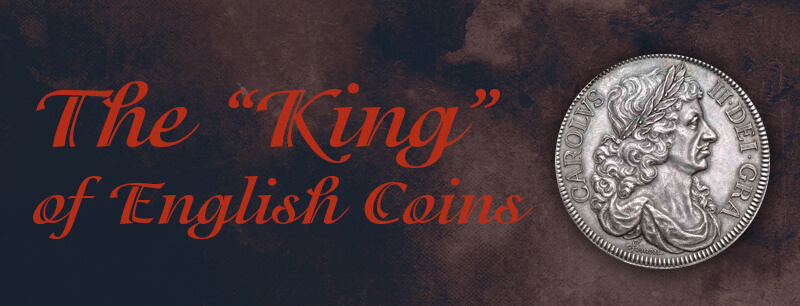
One of the most celebrated coins in English history is Thomas Simon’s “Petition” Crown of 1663. This glamorous numismatic masterpiece is comparable to the American 1804 dollar for its rarity, history and value to collectors. The coin has its origins in the aftermath of the English Civil Wars and the Restoration of the monarchy under Charles II.
Thomas Simon worked at the Tower Mint during the civil wars and under the Commonwealth, where he eventually earned the post of chief engraver for the mint in 1656 with the support of Oliver Cromwell, who especially admired his work. After the Restoration, Charles II replaced Simon as chief engraver with Thomas Rawlins, who had been promised the position by Charles I in 1645. Charles II allowed Simon to remain an engraver at the mint, in spite of his close ties to Cromwell and the Commonwealth. In February of 1662, the king instructed Simon and the Dutch Roettiers brothers to prepare patterns for a new milled coinage. Simon was unable to produce a pattern in the required time, and the Roettiers design was chosen by default, much to Simon’s dismay. Then, in 1663, the king ordered the Roettiers to make minor changes to their dies, and Simon took the opportunity to create the “Petition” Crown – a masterpiece of numismatic art – in an attempt to have the king accept his design.
Simon’s pattern is known as the “Petition” Crown because of the petition he engraved in two lines on the edge: “THOMAS SIMON MOST HVMBLY PRAYS YOVR MAJESTY TO COMPARE THIS HIS TRYALL PIECE WITH THE DVTCH AND IF MORE / TRVLY DRAWN & EMBOSS’D MORE GRACE FVLLY ORDERED AND MORE ACCVRATELY ENGRAVEN TO RELEIVE HIM.” Unfortunately, despite the clear superiority of his work, Simon’s “Petition” Crown was not accepted. Today 12 of these coins are known to exist.
John and Joseph Roettiers Pattern Crown of 1662
The Roettiers family lent money to Charles II while he was in exile in Holland. The king returned the favor by hiring the sons John and Joseph Roettiers to work as engravers at the Royal Mint in 1661. In 1662, they were asked to produce a pattern for the new milled coinage to be produced for Charles II using Peter Blondeau’s mechanized coining process. Thomas Simon, who had worked closely with Blondeau during the Commonwealth and Protectorate and who was responsible for Blondeau’s return to the mint, was also asked to prepare a pattern for the king’s review. The Roettiers design, which was accepted by the king when Simon failed to produce one of his own, became the model for the new coinage.
Click on the items in the case image below for an enhanced view
